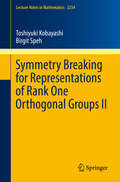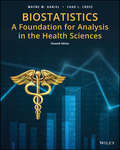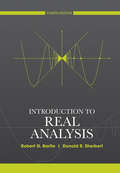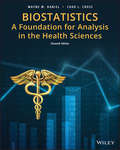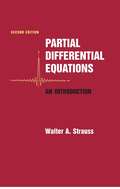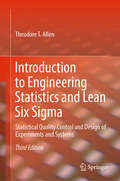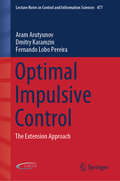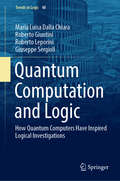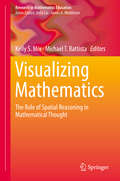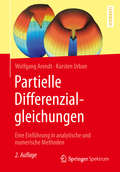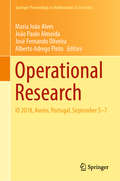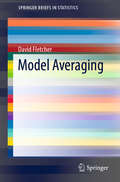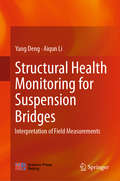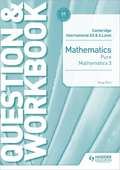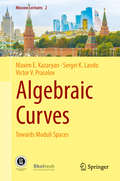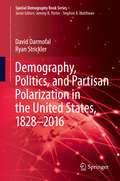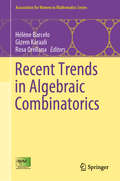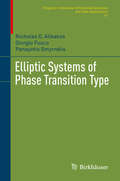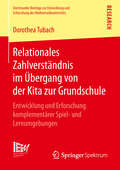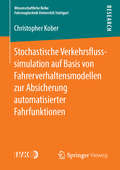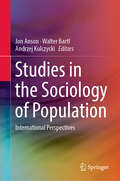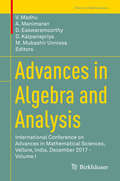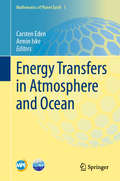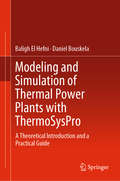- Table View
- List View
Symmetry Breaking for Representations of Rank One Orthogonal Groups II (Lecture Notes in Mathematics #2234)
by Birgit Speh Toshiyuki KobayashiThis work provides the first classification theory of matrix-valued symmetry breaking operators from principal series representations of a reductive group to those of its subgroup.The study of symmetry breaking operators (intertwining operators for restriction) is an important and very active research area in modern representation theory, which also interacts with various fields in mathematics and theoretical physics ranging from number theory to differential geometry and quantum mechanics.The first author initiated a program of the general study of symmetry breaking operators. The present book pursues the program by introducing new ideas and techniques, giving a systematic and detailed treatment in the case of orthogonal groups of real rank one, which will serve as models for further research in other settings.In connection to automorphic forms, this work includes a proof for a multiplicity conjecture by Gross and Prasad for tempered principal series representations in the case (SO(n + 1, 1), SO(n, 1)). The authors propose a further multiplicity conjecture for nontempered representations.Viewed from differential geometry, this seminal work accomplishes the classification of all conformally covariant operators transforming differential forms on a Riemanniann manifold X to those on a submanifold in the model space (X, Y) = (Sn, Sn-1). Functional equations and explicit formulæ of these operators are also established.This book offers a self-contained and inspiring introduction to the analysis of symmetry breaking operators for infinite-dimensional representations of reductive Lie groups. This feature will be helpful for active scientists and accessible to graduate students and young researchers in representation theory, automorphic forms, differential geometry, and theoretical physics.
Biostatistics: A Foundation for Analysis in the Health Sciences (Wiley Series In Probability And Statistics: Probability And Statistics Section Ser. #Vol. 468)
by Wayne W. Daniel Chad L. CrossThe ability to analyze and interpret enormous amounts of data has become a prerequisite for success in allied healthcare and the health sciences. Now in its 11th edition, Biostatistics: A Foundation for Analysis in the Health Sciences continues to offer in-depth guidance toward biostatistical concepts, techniques, and practical applications in the modern healthcare setting. Comprehensive in scope yet detailed in coverage, this text helps students understand—and appropriately use—probability distributions, sampling distributions, estimation, hypothesis testing, variance analysis, regression, correlation analysis, and other statistical tools fundamental to the science and practice of medicine. Clearly-defined pedagogical tools help students stay up-to-date on new material, and an emphasis on statistical software allows faster, more accurate calculation while putting the focus on the underlying concepts rather than the math. Students develop highly relevant skills in inferential and differential statistical techniques, equipping them with the ability to organize, summarize, and interpret large bodies of data. Suitable for both graduate and advanced undergraduate coursework, this text retains the rigor required for use as a professional reference.
Introduction to Real Analysis
by Robert G. Bartle Donald R. SherbertThis text provides the fundamental concepts and techniques of real analysis for students in all of these areas. It helps one develop the ability to think deductively, analyze mathematical situations, and extend ideas to a new context. Like the first three editions, this edition maintains the same spirit and user-friendly approach with additional examples and expansion on Logical Operations and Set Theory. There is also content revision in the following areas: Introducing point-set topology before discussing continuity, including a more thorough discussion of limsup and limimf, covering series directly following sequences, adding coverage of Lebesgue Integral and the construction of the reals, and drawing student attention to possible applications wherever possible.
Biostatistics: A Foundation for Analysis in the Health Sciences
by Wayne W. Daniel Chad L. CrossThe ability to analyze and interpret enormous amounts of data has become a prerequisite for success in allied healthcare and the health sciences. Now in its 11th edition, Biostatistics: A Foundation for Analysis in the Health Sciences continues to offer in-depth guidance toward biostatistical concepts, techniques, and practical applications in the modern healthcare setting. Comprehensive in scope yet detailed in coverage, this text helps students understand—and appropriately use—probability distributions, sampling distributions, estimation, hypothesis testing, variance analysis, regression, correlation analysis, and other statistical tools fundamental to the science and practice of medicine. Clearly-defined pedagogical tools help students stay up-to-date on new material, and an emphasis on statistical software allows faster, more accurate calculation while putting the focus on the underlying concepts rather than the math. Students develop highly relevant skills in inferential and differential statistical techniques, equipping them with the ability to organize, summarize, and interpret large bodies of data. Suitable for both graduate and advanced undergraduate coursework, this text retains the rigor required for use as a professional reference.
Partial Differential Equations: An Introduction
by Walter A. StraussPartial Differential Equations presents a balanced and comprehensive introduction to the concepts and techniques required to solve problems containing unknown functions of multiple variables. While focusing on the three most classical partial differential equations (PDEs)—the wave, heat, and Laplace equations—this detailed text also presents a broad practical perspective that merges mathematical concepts with real-world application in diverse areas including molecular structure, photon and electron interactions, radiation of electromagnetic waves, vibrations of a solid, and many more. Rigorous pedagogical tools aid in student comprehension; advanced topics are introduced frequently, with minimal technical jargon, and a wealth of exercises reinforce vital skills and invite additional self-study. Topics are presented in a logical progression, with major concepts such as wave propagation, heat and diffusion, electrostatics, and quantum mechanics placed in contexts familiar to students of various fields in science and engineering. By understanding the properties and applications of PDEs, students will be equipped to better analyze and interpret central processes of the natural world.
Introduction to Engineering Statistics and Lean Six Sigma: Statistical Quality Control and Design of Experiments and Systems
by Theodore T. AllenThis book provides an accessible one-volume introduction to Lean Six Sigma and statistics in engineering for students and industry practitioners. Lean production has long been regarded as critical to business success in many industries. Over the last ten years, instruction in Six Sigma has been linked more and more with learning about the elements of lean production. Building on the success of the first and second editions, this book expands substantially on major topics of increasing relevance to organizations interested in Lean Six Sigma. Each chapter includes summaries and review examples plus problems with their solutions. As well as providing detailed definitions and case studies of all Six Sigma methods, the book uniquely describes the relationship between operations research techniques and Lean Six Sigma. Further, this new edition features more introductory material on probability and inference and information about Deming's philosophy, human factors engineering, and the motivating potential score – the material is tied more directly to the Certified Quality Engineer (CQE) exam. New sections that explore motivation and change management, which are critical subjects for achieving valuable results have also been added. The book examines in detail Design For Six Sigma (DFSS), which is critical for many organizations seeking to deliver desirable products. It covers reliability, maintenance, and product safety, to fully span the CQE body of knowledge. It also incorporates recently emerging formulations of DFSS from industry leaders and offers more introductory material on experiment design, and includes practical experiments that will help improve students’ intuition and retention. The emphasis on lean production, combined with recent methods relating to DFSS, makes this book a practical, up-to-date resource for advanced students, educators and practitioners.
Optimal Impulsive Control: The Extension Approach (Lecture Notes in Control and Information Sciences #477)
by Fernando Lobo Pereira Dmitry Karamzin Aram ArutyunovOptimal Impulsive Control explores the class of impulsive dynamic optimization problems—problems that stem from the fact that many conventional optimal control problems do not have a solution in the classical setting—which is highly relevant with regard to engineering applications. The absence of a classical solution naturally invokes the so-called extension, or relaxation, of a problem, and leads to the notion of generalized solution which encompasses the notions of generalized control and trajectory; in this book several extensions of optimal control problems are considered within the framework of optimal impulsive control theory. In this framework, the feasible arcs are permitted to have jumps, while the conventional absolutely continuous trajectories may fail to exist. The authors draw together various types of their own results, centered on the necessary conditions of optimality in the form of Pontryagin’s maximum principle and the existence theorems, which shape a substantial body of optimal impulsive control theory. At the same time, they present optimal impulsive control theory in a unified framework, introducing the different paradigmatic problems in increasing order of complexity. The rationale underlying the book involves addressing extensions increasing in complexity from the simplest case provided by linear control systems and ending with the most general case of a totally nonlinear differential control system with state constraints.The mathematical models presented in Optimal Impulsive Control being encountered in various engineering applications, this book will be of interest to both academic researchers and practising engineers.
Quantum Computation and Logic: How Quantum Computers Have Inspired Logical Investigations (Trends in Logic #48)
by Maria Luisa Dalla Chiara Roberto Giuntini Roberto Leporini Giuseppe SergioliThis book provides a general survey of the main concepts, questions and results that have been developed in the recent interactions between quantum information, quantum computation and logic. Divided into 10 chapters, the books starts with an introduction of the main concepts of the quantum-theoretic formalism used in quantum information. It then gives a synthetic presentation of the main “mathematical characters” of the quantum computational game: qubits, quregisters, mixtures of quregisters, quantum logical gates. Next, the book investigates the puzzling entanglement-phenomena and logically analyses the Einstein–Podolsky–Rosen paradox and introduces the reader to quantum computational logics, and new forms of quantum logic. The middle chapters investigate the possibility of a quantum computational semantics for a language that can express sentences like “Alice knows that everybody knows that she is pretty”, explore the mathematical concept of quantum Turing machine, and illustrate some characteristic examples that arise in the framework of musical languages. The book concludes with an analysis of recent discussions, and contains a Mathematical Appendix which is a survey of the definitions of all main mathematical concepts used in the book.
Visualizing Mathematics: The Role Of Spatial Reasoning In Mathematical Thought (Research In Mathematics Education Ser.)
by Kelly S. Mix Michael T. BattistaThis unique volume surveys recent research on spatial visualization in mathematics in the fields of cognitive psychology and mathematics education. The general topic of spatial skill and mathematics has a long research tradition, but has been gaining attention in recent years, although much of this research happens in disconnected subfields. This volume aims to promote interaction between researchers, not only to provide a more comprehensive view of spatial visualization and mathematics, but also to stimulate innovative new directions in research based on a more coordinated effort. It features ten chapters authored by leading researchers in cognitive psychology and mathematics education, as well as includes dynamic commentaries by mathematics education researchers on cognitive psychology chapters, and by cognitive psychologists on mathematics education chapters. Among the topics included: From intuitive spatial measurement to understanding of units. Spatial reasoning: a critical problem-solving tool in children’s mathematics strategy tool-kit. What processes underlie the relation between spatial skill and mathematics? Learning with and from drawing in early years geometry. Communication of visual information and complexity of reasoning by mathematically talented students. Visualizing Mathematics makes substantial progress in understanding the role of spatial reasoning in mathematical thought and in connecting various subfields of research. It promises to make an impact among psychologists, education scholars, and mathematics educators in the convergence of psychology and education.
Partielle Differenzialgleichungen: Eine Einführung in analytische und numerische Methoden
by Wolfgang Arendt Karsten UrbanDieses Lehrbuch gibt eine Einführung in die partiellen Differenzialgleichungen. Wir beginnen mit einigen ganz konkreten Beispielen aus den Natur-, Ingenieur und Wirtschaftswissenschaften. Danach werden elementare Lösungsmethoden dargestellt, z.B. für die Black-Scholes-Gleichung aus der Finanzmathematik. Schließlich wird die analytische Untersuchung großer Klassen von partiellen Differenzialgleichungen dargestellt, wobei Hilbert-Raum-Methoden im Mittelpunkt stehen. Numerische Verfahren werden eingeführt und mit konkreten Beispielen behandelt. Zu jedem Kapitel finden sich Übungsaufgaben, mit deren Hilfe der Stoff eingeübt und vertieft werden kann. Dieses Buch richtet sich an Studierende im Bachelor oder im ersten Master-Jahr sowohl in der (Wirtschafts-)Mathematik als auch in den Studiengängen Informatik, Physik und Ingenieurwissenschaften.Die 2. Auflage ist vollständig durchgesehen, an vielen Stellen didaktisch weiter optimiert und um die Beschreibung variationeller Methoden in Raum und Zeit für zeitabhängige Probleme ergänzt.Stimme zur ersten AuflageAuf dieses Lehrbuch haben wir gewartet.Prof. Dr. Andreas Kleinert in zbMATH
Operational Research: IO 2018, Aveiro, Portugal, September 5-7 (Springer Proceedings in Mathematics & Statistics #278)
by Maria João Alves João Paulo Almeida José Fernando Oliveira Alberto Adrego PintoThis book gathers selected contributions by top Portuguese and international researchers in the field of Operations Research, presented at the 19th Congress of APDIO (Portuguese Association of Operational Research). The papers address a broad range of complex real-world problems, which are approached using recent theoretical techniques. Of particular interest are the applications of e.g. linear, nonlinear and mixed-integer programming, multiobjective optimization, metaheuristics and hybrid heuristics, multicriteria decision analysis, data envelopment analysis, clustering techniques and decision support systems, in such varied contexts as: supply chain management, scheduling problems, production management, logistics, energy, finance and healthcare. This conference, organized by APDIO and held in Aveiro, Portugal in September 2018, offered an ideal opportunity to discuss the latest developments in this field and to build new bridges between academic researchers and practitioners. Summarizing the outcomes, this book offers a valuable tool for all researchers, students and practitioners who wish to learn about the latest trends in this field.
Model Averaging (SpringerBriefs in Statistics)
by David FletcherThis book provides a concise and accessible overview of model averaging, with a focus on applications. Model averaging is a common means of allowing for model uncertainty when analysing data, and has been used in a wide range of application areas, such as ecology, econometrics, meteorology and pharmacology. The book presents an overview of the methods developed in this area, illustrating many of them with examples from the life sciences involving real-world data. It also includes an extensive list of references and suggestions for further research. Further, it clearly demonstrates the links between the methods developed in statistics, econometrics and machine learning, as well as the connection between the Bayesian and frequentist approaches to model averaging. The book appeals to statisticians and scientists interested in what methods are available, how they differ and what is known about their properties. It is assumed that readers are familiar with the basic concepts of statistical theory and modelling, including probability, likelihood and generalized linear models.
Structural Health Monitoring for Suspension Bridges: Interpretation of Field Measurements
by Yang Deng Aiqun LiThis book presents extensive information on structural health monitoring for suspension bridges. During the past two decades, there have been significant advances in the sensing technologies employed in long-span bridge health monitoring. However, interpretation of the massive monitoring data is still lagging behind. This book establishes a series of measurement interpretation frameworks that focus on bridge site environmental conditions, and global and local responses of suspension bridges. Using the proposed frameworks, it subsequently offers new insights into the structural behaviors of long-span suspension bridges. As a valuable resource for researchers, scientists and engineers in the field of bridge structural health monitoring, it provides essential information, methods, and practical algorithms that can facilitate in-service bridge performance assessments.
Cambridge International AS & A Level Mathematics Pure Mathematics 3 Question & Workbook
by Greg PortReinforce learning and deepen understanding of the key concepts covered in the syllabus; an ideal course companion or homework book for use throughout the course.- Develop and strengthen skills and knowledge with a wealth of additional exercises that perfectly supplement the Student's Book- Build confidence with extra practice for each lesson to ensure that a topic is thoroughly understood before moving on- Ensure students know what to expect with hundreds of rigorous practice and exam-style questions.- Keep track of students' work with ready-to-go write-in exercisesThis title has not been through the Cambridge Assessment International Education endorsement process.
Algebraic Curves: Towards Moduli Spaces (Moscow Lectures #2)
by Maxim E. Kazaryan Sergei K. Lando Victor V. PrasolovThis book offers a concise yet thorough introduction to the notion of moduli spaces of complex algebraic curves. Over the last few decades, this notion has become central not only in algebraic geometry, but in mathematical physics, including string theory, as well.The book begins by studying individual smooth algebraic curves, including the most beautiful ones, before addressing families of curves. Studying families of algebraic curves often proves to be more efficient than studying individual curves: these families and their total spaces can still be smooth, even if there are singular curves among their members. A major discovery of the 20th century, attributed to P. Deligne and D. Mumford, was that curves with only mild singularities form smooth compact moduli spaces. An unexpected byproduct of this discovery was the realization that the analysis of more complex curve singularities is not a necessary step in understanding the geometry of the moduli spaces.The book does not use the sophisticated machinery of modern algebraic geometry, and most classical objects related to curves – such as Jacobian, space of holomorphic differentials, the Riemann-Roch theorem, and Weierstrass points – are treated at a basic level that does not require a profound command of algebraic geometry, but which is sufficient for extending them to vector bundles and other geometric objects associated to moduli spaces. Nevertheless, it offers clear information on the construction of the moduli spaces, and provides readers with tools for practical operations with this notion.Based on several lecture courses given by the authors at the Independent University of Moscow and Higher School of Economics, the book also includes a wealth of problems, making it suitable not only for individual research, but also as a textbook for undergraduate and graduate coursework
Demography, Politics, and Partisan Polarization in the United States, 1828–2016 (Spatial Demography Book Series #2)
by David Darmofal Ryan StricklerThis book examines the geography of partisan polarization, or the Reds and Blues, of the political landscape in the United States. It places the current schism between Democrats and Republicans within a historical context and presents a theoretical framework that offers unique insights into the American electorate. The authors focus on the demographic and political causes of polarization at the local level across space and time. This is accomplished with the aid of a comprehensive dataset that includes the presidential election results for every county in the continental United States, from the advent of Jacksonian democracy in 1828 to the 2016 election. In addition, coverage applies spatial diagnostics, spatial lag models and spatial error models to determine why contemporary and historical elections in the United States have exhibited their familiar, but heretofore unexplained, political geography. Both popular observers and scholars alike have expressed concern that citizens are becoming increasingly polarized and, as a consequence, that democratic governance is beginning to break down. This book argues that once current levels of polarization are placed within a historical context, the future does not look quite so bleak. Overall, readers will discover that partisan division is a dynamic process in large part due to the complex interplay between changing demographics and changing politics.
Recent Trends in Algebraic Combinatorics (Association for Women in Mathematics Series #16)
by Hélène Barcelo Gizem Karaali Rosa OrellanaThis edited volume features a curated selection of research in algebraic combinatorics that explores the boundaries of current knowledge in the field. Focusing on topics experiencing broad interest and rapid growth, invited contributors offer survey articles on representation theory, symmetric functions, invariant theory, and the combinatorics of Young tableaux. The volume also addresses subjects at the intersection of algebra, combinatorics, and geometry, including the study of polytopes, lattice points, hyperplane arrangements, crystal graphs, and Grassmannians. All surveys are written at an introductory level that emphasizes recent developments and open problems. An interactive tutorial on Schubert Calculus emphasizes the geometric and topological aspects of the topic and is suitable for combinatorialists as well as geometrically minded researchers seeking to gain familiarity with relevant combinatorial tools.Featured authors include prominent women in the field known for their exceptional writing of deep mathematics in an accessible manner. Each article in this volume was reviewed independently by two referees. The volume is suitable for graduate students and researchers interested in algebraic combinatorics.
Elliptic Systems of Phase Transition Type (Progress in Nonlinear Differential Equations and Their Applications #91)
by Nicholas D. Alikakos Giorgio Fusco Panayotis SmyrnelisThis book focuses on the vector Allen-Cahn equation, which models coexistence of three or more phases and is related to Plateau complexes – non-orientable objects with a stratified structure. The minimal solutions of the vector equation exhibit an analogous structure not present in the scalar Allen-Cahn equation, which models coexistence of two phases and is related to minimal surfaces. The 1978 De Giorgi conjecture for the scalar problem was settled in a series of papers: Ghoussoub and Gui (2d), Ambrosio and Cabré (3d), Savin (up to 8d), and del Pino, Kowalczyk and Wei (counterexample for 9d and above). This book extends, in various ways, the Caffarelli-Córdoba density estimates that played a major role in Savin's proof. It also introduces an alternative method for obtaining pointwise estimates. Key features and topics of this self-contained, systematic exposition include: • Resolution of the structure of minimal solutions in the equivariant class, (a) for general point groups, and (b) for general discrete reflection groups, thus establishing the existence of previously unknown lattice solutions. • Preliminary material beginning with the stress-energy tensor, via which monotonicity formulas, and Hamiltonian and Pohozaev identities are developed, including a self-contained exposition of the existence of standing and traveling waves. • Tools that allow the derivation of general properties of minimizers, without any assumptions of symmetry, such as a maximum principle or density and pointwise estimates. • Application of the general tools to equivariant solutions rendering exponential estimates, rigidity theorems and stratification results. This monograph is addressed to readers, beginning from the graduate level, with an interest in any of the following: differential equations – ordinary or partial; nonlinear analysis; the calculus of variations; the relationship of minimal surfaces to diffuse interfaces; or the applied mathematics of materials science.
Relationales Zahlverständnis im Übergang von der Kita zur Grundschule: Entwicklung und Erforschung komplementärer Spiel- und Lernumgebungen (Dortmunder Beiträge zur Entwicklung und Erforschung des Mathematikunterrichts #41)
by Dorothea TubachDer Entwicklung des relationalen Zahlverständnisses kommt im Übergang von der Kita in die Grundschule, d.h. im Alter von vier bis sechs Jahren, besondere Bedeutung zu. Dorothea Tubach stellt zwei komplementäre Spiel- und Lernumgebungen vor, die beide eine authentische mathematische Lernsituation für den jeweiligen Lernort in Kita und Anfangsunterricht bieten. Sie sind gleichsam aufeinander bezogen und nutzen mathematisches Spiel als Designelement. Die rekonstruierten Deutungen zum relationalen Zahlverständnis der Kinder zeigen, dass komplementäre Spiel- und Lernumgebungen einen Beitrag zur Übergangsgestaltung leisten können. Die Charakterisierung der jeweiligen Spiel- und Lernsituationen erlaubt die Ausschärfung des Begriffs des mathematischen Spiels.
Stochastische Verkehrsflusssimulation auf Basis von Fahrerverhaltensmodellen zur Absicherung automatisierter Fahrfunktionen (Wissenschaftliche Reihe Fahrzeugtechnik Universität Stuttgart)
by Christopher KoberChristopher Kober beschreibt eine Methode, realistischen deutschen Autobahnverkehr zu simulieren. Dadurch kann er Fahrerassistenz- und automatisierte Funktionen umfangreicher als bisher in der Simulation und im Labor testen. Der Verkehrsfluss entsteht durch die Interaktion von Fahrerverhaltensmodellen, die er anhand statistischer Untersuchungen parametriert. Den Bezug zu realem Verkehrsfluss stellt der Autor über zwei Fahrsimulatorstudien sowie über die Auswertung von Zählstellendaten her.Der Autor: Christopher Kober arbeitet derzeit im Bereich E/E Testing Prüfstand bei einem deutschen Automobilhersteller. Dort ist er themenverantwortlich für die „Digitale Erprobungsfahrt“, die sich zum Ziel gesetzt hat, eine reale Erprobung durch komplexe Simulation nachzubilden, um E/E-Komponenten im Labor zu testen. Er promovierte berufsbegleitend am Institut für Verbrennungsmotoren und Kraftfahrwesen (IVK) der Universität Stuttgart.
Studies in the Sociology of Population: International Perspectives
by Jon Anson Walter Bartl Andrzej KulczyckiThis book presents a cross section of the work and concerns of social demographers worldwide, covering a broad range of topics from social structure through population structure to social policy; from fertility and mortality through migration to the way in which organisations deal with the demographic environment in which they operate. Topics addressed also include morbidity and health profiles and transitions, as well as policies and programs concerned with these and other issues. The volume touches on some of the major links between population and societal dynamics. It addresses demographic patterns and issues from micro-level, meso-level, and macro-level perspectives and helps put into focus the past, present and future of the mutual relations between population dynamics and societal responses. With a unique introductory chapter discussing the global unevenness of population growth today, its associations with inequality and the challenges it presents for the future, and a truly international approach to social and demographic change and policy responses, this book will serve as a valuable resource for professionals and students in sociology, demography, social policy and local governance.
Advances in Algebra and Analysis: International Conference on Advances in Mathematical Sciences, Vellore, India, December 2017 - Volume I (Trends in Mathematics)
by V. Madhu A. Manimaran D. Easwaramoorthy D. Kalpanapriya M. Mubashir UnnissaThis volume is the first of two containing selected papers from the International Conference on Advances in Mathematical Sciences, Vellore, India, December 2017 - Volume I. This meeting brought together researchers from around the world to share their work, with the aim of promoting collaboration as a means of solving various problems in modern science and engineering. The authors of each chapter present a research problem, techniques suitable for solving it, and a discussion of the results obtained. These volumes will be of interest to both theoretical- and application-oriented individuals in academia and industry.Papers in Volume I are dedicated to active and open areas of research in algebra, analysis, operations research, and statistics, and those of Volume II consider differential equations, fluid mechanics, and graph theory.
Energy Transfers in Atmosphere and Ocean (Mathematics of Planet Earth #1)
by Carsten Eden Armin IskeThis book describes a recent effort combining interdisciplinary expertise within the Collaborative Research Centre “Energy transfers in atmosphere and ocean” (TRR-181), which was funded by the German Research Foundation (DFG). Energy transfers between the three dynamical regimes – small-scale turbulence, internal gravity waves and geostrophically balanced motion – are fundamental to the energy cycle of both the atmosphere and the ocean. Nonetheless, they remain poorly understood and quantified, and have yet to be adequately represented in today’s climate models. Since interactions between the dynamical regimes ultimately link the smallest scales to the largest ones through a range of complex processes, understanding these interactions is essential to constructing atmosphere and ocean models and to predicting the future climate. To this end, TRR 181 combines expertise in applied mathematics, meteorology, and physical oceanography. This book provides an overview of representative specific topics addressed by TRR 181, ranging from - a review of a coherent hierarchy of models using consistent scaling and approximations, and revealing the underlying Hamiltonian structure - a systematic derivation and implementation of stochastic and backscatter parameterisations - an exploration of the dissipation of large-scale mean or eddying balanced flow and ocean eddy parameterisations; and - a study on gravity wave breaking and mixing, the interaction of waves with the mean flow and stratification, wave-wave interactions and gravity wave parameterisations to topics of a more numerical nature such as the spurious mixing and dissipation of advection schemes, and direct numerical simulations of surface waves at the air-sea interface. In TRR 181, the process-oriented topics presented here are complemented by an operationally oriented synthesis focusing on two climate models currently being developed in Germany. In this way, the goal of TRR 181 is to help reduce the biases in and increase the accuracy of atmosphere and ocean models, and ultimately to improve climate models and climate predictions.
Modeling and Simulation of Thermal Power Plants with ThermoSysPro: A Theoretical Introduction and a Practical Guide
by Baligh El Hefni Daniel BouskelaThis book explains the modelling and simulation of thermal power plants, and introduces readers to the equations needed to model a wide range of industrial energy processes. Also featuring a wealth of illustrative, real-world examples, it covers all types of power plants, including nuclear, fossil-fuel, solar and biomass. The book is based on the authors’ expertise and experience in the theory of power plant modelling and simulation, developed over many years of service with EDF. In more than forty examples, they demonstrate the component elements involved in a broad range of energy production systems, with detailed test cases for each chemical, thermodynamic and thermo-hydraulic model. Each of the test cases includes the following information: • component description and parameterization data; • modelling hypotheses and simulation results; • fundamental equations and correlations, with their validity domains; • model validation, and in some cases, experimental validation; and • single-phase flow and two-phase flow modelling equations, which cover all water and steam phases. A practical volume that is intended for a broad readership, from students and researchers, to professional engineers, this book offers the ideal handbook for the modelling and simulation of thermal power plants. It is also a valuable aid in understanding the physical and chemical phenomena that govern the operation of power plants and energy processes.
